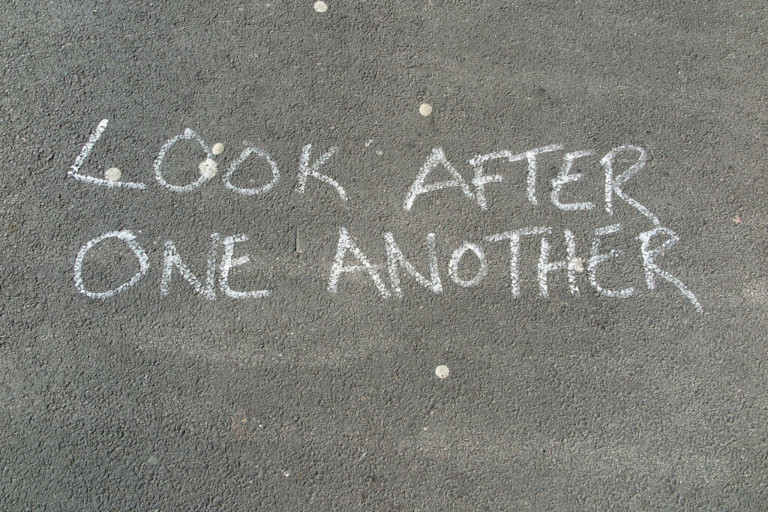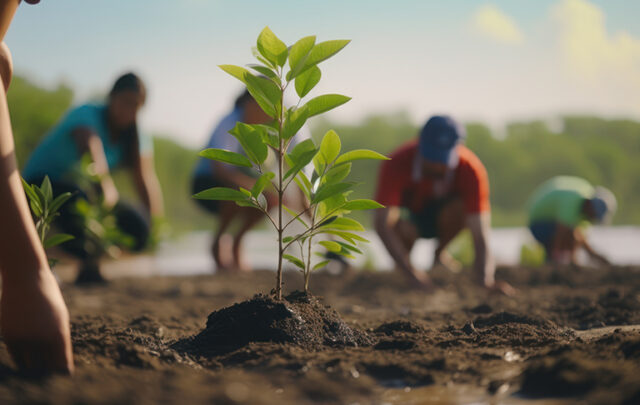When the COVID-19 pandemic hit, it caused cataclysms that cascaded throughout healthcare, public transport, delivery services, and food systems. In doing so, it laid bare an ugly truth of the U.S. economy: Although certain services are essential, the humans who provide them are disposable—even sacrificial.
While many people were able to work from home, others—compelled by the nature of their employment—were given three choices: Put their lives on the line, be financially crushed, or both.
While the dominant U.S. economic system operates on this principle of persistent financial coercion, there is (and always have been) an alternative way to organize individuals into collectives providing essential services, without the need for coercion: mutual aid networks.
At its core, a mutual aid network is a volunteer system of people helping people and communities helping communities.
Although the pandemic brought it top-of-mind for many, mutual aid is not new. Systemically oppressed communities, especially Black communities in the U.S., have continuously used mutual aid networks to share essential services.
Scholar Jessica Gordon Nembhard says in her book, Collective Courage: A History of African American Cooperative Economic Thought and Practice, that mutual aid societies were a cornerstone of African-American communities. A notable one is the Free African Society, formed in Philadelphia a decade after the signing of the Declaration of Independence. By 1830, more than a hundred mutual aid societies existed in Philadelphia alone.
So drawing from existing knowledge instead of reinventing the wheel, this article is a guide to starting or increasing the capacity of, a mutual aid network.
Start small and start anywhere with a core team
It’s OK to not have a grand plan to save the world when starting a mutual aid network. In fact, it’s better if you don’t—mutual aid is a complex, emergent process where each member’s abilities and ideas are respected. It also operates on a local scale. Not knowing all the answers—and being able to admit that—is a good start.
Effective organizing is first and foremost about people and the strong relationships among them. The first thing to do is to develop a core team. Organizing requires spending a lot of time together, so think about people you trust and who are committed to showing up.
In March 2020, Congresswoman Alexandria Ocasio-Cortez hosted a conversation with activist and mutual aid organizer Mariame Kaba on how to start a network like this. The resources discussed in this training were compiled into a very useful and concise Mutual Aid 101 Toolkit, accessible to anyone for free. This toolkit advises that if you don’t know what to do at first, start by asking someone close to you to help brainstorm and make connections that will help you understand community needs. After that, reach out and try to form a small group of five to 20 people.
A common tool to use to think about who to reach out to is a pod map. A pod map is a simple way of visualizing the people in your life that you’re already connected to—people who can provide for your basic needs and who, in turn, you can provide for. Pod mapping also allows you to visualize the individuals and organizations that you could get in contact with and deepen relationships with.
There’s a great pod mapping resource created by Rebel Sidney Black, adapted in an open-source spirit from a tool developed by the Bay Area Transformative Justice Collective to deal with harm in communities.
Make local connections
The Mutual Aid 101 Toolkit suggests clearly identifying the support area and to start making connections.
Madison-based organizer Stephanie Rearick is a co-founder of the HUMANs (Humans United in Mutual Aid Networks) global network of mutual aid groups. She says,
“We are about making the longer-term systemic change… any time we can build more of a commons and pull things out of a need to be transactional, we think that’s the way to find the most abundance,” said Rearick. “We all have value, everyone deserves to have their needs met, and we all have something to provide.”
To make connections, the toolkit suggests questions that can help discover the needs and abilities of neighbors, like: “What are your hobbies and interests?” and “What are your needs?” “What are you afraid of losing?” “What do you need help with?” It also has some useful suggestions about how to handle larger groups.
Build on existing networks
Reach out to existing organizations serving underrepresented and vulnerable populations in your community. These groups may have the capacity to offer services or could help by tapping into their existing community connections. Mutual Aid Hub has a searchable map to find groups near you.
Taking the time to seek out these groups is vital. Likely, there are already groups near you.
Maintain regular, deep communication
Once your network has grown to connect people, organizations, and communities, one-on-one communication will remain important. Although social media, email lists, and blog posts can spread messages far and wide, it is wise to also maintain the practice of deepening connections through one-on-one conversation.
This type of communication has better outcomes when mobilizing people, seeking information about needs and resources, and spreading a specific message. It also reinforces the cohesion of the network.
Phone trees are often employed so conversations can happen quickly and efficiently while dividing effort among members. The toolkit links to a resource on how to build a phone tree, which should be established and used regularly.
Adapt to community needs
A mutual aid group should be an adaptive organism, designed to be responsive to community needs. “One of the things that I’m pretty proud that we’ve done is be[ing] really responsive to community needs and figur[ing] out how to respond to those needs in a really quick way and not being bogged down in systems,” said Juliana Garcia, a facilitator of Mutual Aid Tompkins around Ithaca, New York.
Their network began as an information clearinghouse and then grew into a hub for making connections. “I think our role has largely been networking and collecting resources,” said Josh Dolan, who is also a facilitator with Mutual Aid Tompkins. Dolan said community members often self-organize using Mutual Aid Tompkins’ Facebook pages. “All the physical work is being done by volunteers.”
Not only should the activities of the group be adaptive but so should the very structure of the group. From groups of mask-makers to cabinet-builders to an older adults working group, many of the collectives and network programs developed organically.
“The mask-makers are a really good example of that,” Dolan said, referring to the Tompkins Mask Makers, a collective in Tompkins County that sold handmade masks for the region and using their profits to provide masks for those in need. “I know we were kind of working on that initially but then people that have sewing skills and entrepreneurial skills kinda came together and it kind of took off organically… I think it was so successful because at that point, people just wanted to figure out how to help and that was something that people could do at home with the skills that they already have.”
Tap into community resources
Since mutual aid is such a timeless principle, there are ample free resources available that can make starting your own network easier. In addition to the tools mentioned above, another resource for ideas and inspiration is Big Door Brigade. Offering legal support and bail funds, housing, and childcare, the Seattle-based group has links to organizations across a wide range of community providers.
Mutual Aid Networks also has resources, including legal, social, and financial frameworks to help build and maintain networks. The final page of the Mutual Aid 101 Toolkit has an additional list.
If you want to take your mutual aid network to the next level, check out how STL Mutual Aid Fund made it easier for neighbors to help one another and what they’ve learned along the way.
This article was originally published on July 7th, 2020, and has been significantly updated.
This article originally appeared on Shareable.net.





